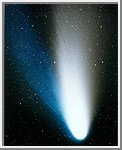
Reveals Comet Origin
June 16, 1999
Thrill seekers may want to hitch a ride on the giant comet Hale-Bopp, but they would fail vehicle emission tests miserably. When it was the same distance from the Sun as Earth, Hale Bopp produced carbon monoxide (CO) emissions equal to that given off by 5.5 billion cars every day.
Just like the results of an emission test help a mechanic diagnose an engine problem, the results of NASA measurements help pin down where Hale-Bopp and many other comets formed. When compared to the quantity of water in the comet, the amount of CO indicates that comet Hale-Bopp was formed in the region between Jupiter and Neptune, according to recent observations.
"Comets are interesting because they are frozen relics from the formation of our solar system, and by studying them, we can learn more about how we got here," said Dr. Michael DiSanti of Catholic University and NASA's Goddard Space Flight Center (Greenbelt, Md.). "Our observations of Hale-Bopp indicate that comets now in the distant Oort cloud were originally part of the solar system's ancient proto-planetary disk. It was thought that comets could have formed in the cold, dense cloud of gas and dust that existed before the proto-planetary disk formed. However, if this were so, we would have seen even more carbon monoxide emission from Hale-Bopp. The amount of carbon monoxide ice compared to water (12 percent) indicates that these comets formed somewhere between the orbits of Jupiter and Neptune. We hope to learn more about what was going on when the giant planets formed by investigating the chemistry of this comet."
CO is a molecule made from a carbon and an oxygen atom. It is normally a gas on Earth, and is monitored in vehicle emissions because it is toxic.
The new results were announced by a team of astronomers from Goddard, Catholic University of America, Rowan University, Iona College, and Notre Dame University. The researchers used an infrared spectrometer on a three- meter telescope -- the NASA Infrared Telescope Facility (IRTF), Mauna Kea Observatory, Hawaii -- to make the observations. "Our observational approach combined with the unusually large size of Hale-Bopp permitted the first definitive measurements of the amounts of carbon monoxide and water present as ices in comets," said Dr. Michael Mumma of Goddard. The research will be published in the June 17 issue of Nature.
Comets, nicknamed "dirty snowballs," are lumps of ice and dust a few miles to a few tens of miles in diameter. Conditions were warmer in the proto-planetary disk than in the gas and dust cloud that preceded it, due to radiation from the nascent Sun. Since water ice freezes at higher temperature than carbon monoxide ice, comets forming in the relatively warm disk would have more water and less carbon monoxide, the researchers believe. After the comets formed, gravitational pulls from gas giant planets in the outer solar system cast them into cold storage about a trillion miles from the Sun, in a roughly spherical region called the Oort cloud. Over the ages, gravity from passing stars perturbs some of these comets, sending them back toward the solar system as celestial visitors from our distant past.
As a comet approaches the Sun, solar heat and radiation liberate gas and dust from the comet's frigid surface, forming a cloud of material (the coma) that is later pulled into the familiar comet tail by pressure from solar wind and radiation. Gas molecules in the coma absorb light from the Sun and emit it again as specific colors. The colors are unique for each chemical in the gas, and serve as an optical "fingerprint" to identify various substances, including CO. Special instruments called spectrometers separate the emitted light, much like a prism separates white light into a rainbow of distinct colors, permitting the identification of these fingerprints.
As the comet nears the Sun, solar heat and light break down different chemicals in its coma. This creates a distributed source of additional carbon monoxide, making it difficult to determine the original amount present as ice in the comet nucleus. The NASA spectrograph can detect the amount of carbon monoxide near the comet nucleus as well as farther out in its coma. "Because Hale-Bopp was so bright, we were able to observe it while still very distant from the Sun before the distributed source was activated. We were thus able to measure carbon monoxide emission solely from the nucleus, and determine the true carbon monoxide to water ratio. Later, as the comet approached the Sun, both sources were active and our measurements then revealed the characteristic spatial signature of the distributed source of CO," said Dr. Neil Dello Russo of Catholic University and Goddard.
"There is another group of comets that may be more like the cold, dense cloud that preceded the solar system disk. Kuiper belt objects lie beyond the orbit of Pluto, and probably formed from remnants at the fringes of the proto-planetary disk. They are believed to be the source of comets with short orbital periods and low inclinations to the ecliptic plane. This region is remote from the Sun, and that part of the disk would have been less influenced by radiation from the young Sun, so ices in Kuiper belt objects are probably more like those in the original cloud from which the solar system formed," said Mumma. "Future measurements may reveal this difference."
Bill Steigerwald Goddard Space Flight Center June 16, 1999 Greenbelt, MD Embargoed Until 2 p.m. EDT William.A.Steigerwald.1@gsfc.nasa.gov (Phone: 301-286-5017) RELEASE NO: 99-76

 Comet
Comet